
The phenomenon of light dispersion is explained with a formula and a practice form for calculating Abbe's number.
- Subject:
- Science
- Material Type:
- Reading
- Provider:
- Georgia State University
- Date Added:
- 08/28/2023

The phenomenon of light dispersion is explained with a formula and a practice form for calculating Abbe's number.
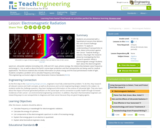
Students are presented with a hypothetical scenario that delivers the unit's Grand Challenge Question: To apply an understanding of nanoparticles to treat, detect and protect against skin cancer. Towards finding a solution, they begin the research phase by investigating the first research question: What is electromagnetic energy? Students learn about the electromagnetic spectrum, ultraviolet radiation (including UVA, UVB and UVC rays), photon energy, the relationship between wave frequency and energy (c = λν), as well as about the Earth's ozone-layer protection and that nanoparticles are being used for medical applications. The lecture material also includes information on photo energy and the dual particle/wave model of light. Students complete a problem set to calculate frequency and energy.
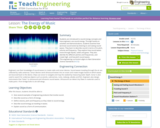
Students are introduced to sound energy concepts and how engineers use sound energy. Through hands-on activities and demonstrations, students examine how we know sound exists by listening to and seeing sound waves. They learn to describe sound in terms of its pitch, volume and frequency. They explore how sound waves move through liquids, solids and gases. They also identify the different pitches and frequencies, and create high- and low-pitch sound waves.
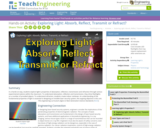
In a hands-on way, students explore light's properties of absorption, reflection, transmission and refraction through various experimental stations within the classroom. To understand absorption, reflection and transmission, they shine flashlights on a number of preselected objects. To understand refraction, students create indoor rainbows. An understanding of the fundamental properties of light is essential to designing an invisible laser security system.
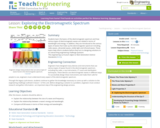
Students learn the basics of the electromagnetic spectrum and how various types of electromagnetic waves are related in terms of wavelength and energy. In addition, they are introduced to the various types of waves that make up the electromagnetic spectrum including, radio waves, ultraviolet waves, visible light and infrared waves. These topics help inform students before they turn to designing solutions to an overarching engineering challenge question.

Join Tarissa and Sabrina as they measure and compare the volume of different sounds across New York City in this video from DragonflyTV.
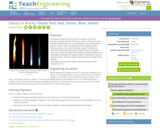
To become familiar with the transfer of energy in the form of quantum, students perform flame tests, which is one way chemical engineers identify elements by observing the color emitted when placed in a flame. After calculating and then preparing specific molarity solutions of strontium chloride, copper II chloride and potassium chloride (good practice!), students observe the distinct colors each solution produces when placed in a flame, determine the visible light wavelength, and apply that data to identify the metal in a mystery solution. They also calculate the frequency of energy for the solutions.

This site from The Florida State University provides an informational page on electromagnetic radiation discusses the characteristics and properties of its many forms including X-rays, gamma rays, ultraviolet radiation, infrared radiation, radio waves, and microwave rays.

In this interactive activity adapted from the University of Utah's ASPIRE Lab, investigate frequency in terms of trampoline jumps, pendulum swings, and electromagnetic waves.
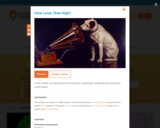
Use the Sound Grapher to create visualizations of sound and learn about the frequency, wavelength, amplitude and velocity of sound waves.

Video provides a basic introduction to the phenomenon of light, the electromagnetic radiation spectrum, wave and particle-like behavior, and how to calculate the wavelength or frequency of a light wave. [9:36]
Khan Academy learning modules include a Community space where users can ask questions and seek help from community members. Educators should consult with their Technology administrators to determine the use of Khan Academy learning modules in their classroom. Please review materials from external sites before sharing with students.

Incredible set of animations demonstrating the Doppler effect and shockwaves resulting from supersonic aircraft.
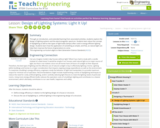
Through an introduction to the design of lighting systems and the electromagnetic spectrum, students learn about the concept of daylighting as well as two types of light bulbs (lamps) often used in energy-efficient lighting design.
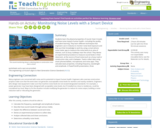
Students learn the physical properties of sound, how it travels and how noise impacts human health—including the quality of student learning. They learn different techniques that engineers use in industry to monitor noise level exposure and then put their knowledge to work by using a smart phone noise meter app to measure the noise level at an area of interest, such as busy roadways near the school. They devise an experimental procedure to measure sound levels in their classroom, at the source of loud noise (such as a busy road or construction site), and in between. Teams collect data using smart phones/tablets, microphones and noise apps. They calculate wave properties, including frequency, wavelength and amplitude. A PowerPoint® presentation, three worksheets and a quiz are provided.

In this thorough lesson, nodes and antinodes are explained and compared to crests and troughs. A "Check Your Understanding," set of questions is included at the end of the lesson with answers.

This video segment, adapted from ZOOM, explores sounds made by homemade drums of different sizes, shapes, and materials. [3:41]

Psychology is designed to meet scope and sequence requirements for the single-semester introduction to psychology course. The book offers a comprehensive treatment of core concepts, grounded in both classic studies and current and emerging research. The text also includes coverage of the DSM-5 in examinations of psychological disorders. Psychology incorporates discussions that reflect the diversity within the discipline, as well as the diversity of cultures and communities across the globe.Senior Contributing AuthorsRose M. Spielman, Formerly of Quinnipiac UniversityContributing AuthorsKathryn Dumper, Bainbridge State CollegeWilliam Jenkins, Mercer UniversityArlene Lacombe, Saint Joseph's UniversityMarilyn Lovett, Livingstone CollegeMarion Perlmutter, University of Michigan


By the end of this section, you will be able to:
Describe important physical features of wave forms
Show how physical properties of light waves are associated with perceptual experience
Show how physical properties of sound waves are associated with perceptual experience
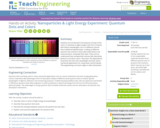
Students are introduced to the physical concept of the colors of rainbows as light energy in the form of waves with distinct wavelengths, but in a different manner than traditional kaleidoscopes. Looking at different quantum dot solutions, they make observations and measurements, and graph their data. They come to understand how nanoparticles interact with absorbing photons to produce colors. They learn the dependence of particle size and color wavelength and learn about real-world applications for using these colorful liquids.